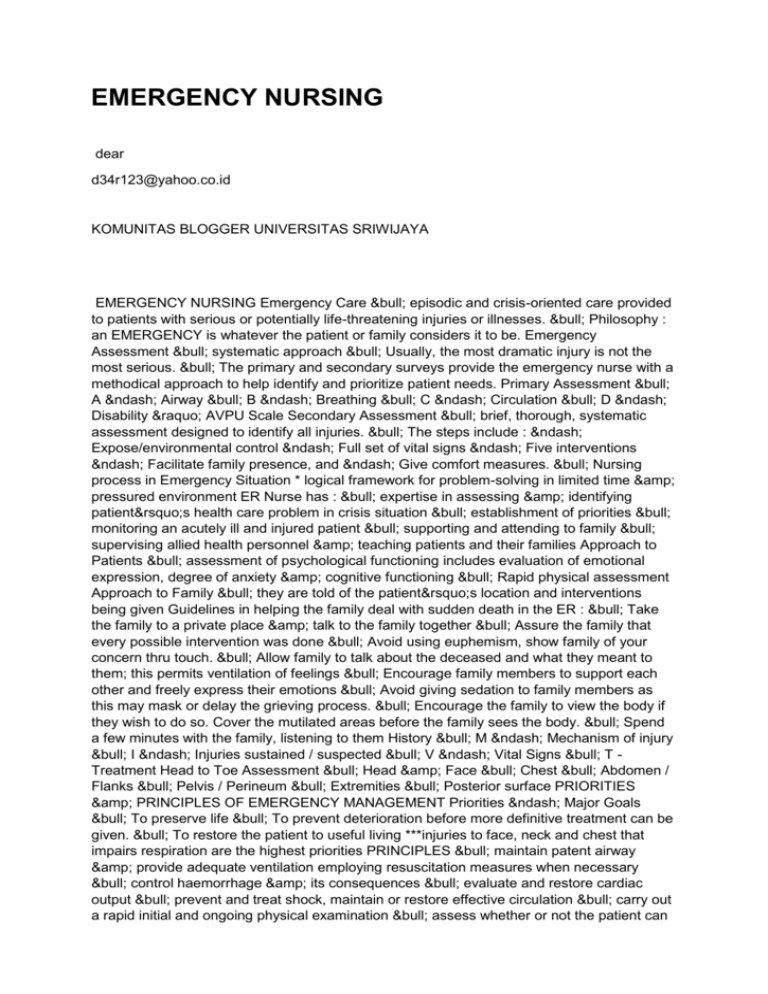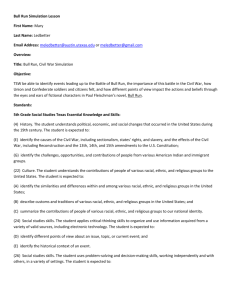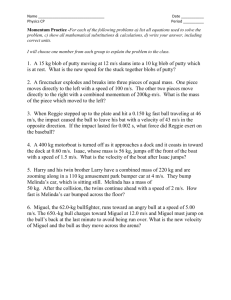emergency nursing - Unsri
advertisement

EMERGENCY NURSING dear d34r123@yahoo.co.id KOMUNITAS BLOGGER UNIVERSITAS SRIWIJAYA EMERGENCY NURSING Emergency Care • episodic and crisis-oriented care provided to patients with serious or potentially life-threatening injuries or illnesses. • Philosophy : an EMERGENCY is whatever the patient or family considers it to be. Emergency Assessment • systematic approach • Usually, the most dramatic injury is not the most serious. • The primary and secondary surveys provide the emergency nurse with a methodical approach to help identify and prioritize patient needs. Primary Assessment • A – Airway • B – Breathing • C – Circulation • D – Disability » AVPU Scale Secondary Assessment • brief, thorough, systematic assessment designed to identify all injuries. • The steps include : – Expose/environmental control – Full set of vital signs – Five interventions – Facilitate family presence, and – Give comfort measures. • Nursing process in Emergency Situation * logical framework for problem-solving in limited time & pressured environment ER Nurse has : • expertise in assessing & identifying patient’s health care problem in crisis situation • establishment of priorities • monitoring an acutely ill and injured patient • supporting and attending to family • supervising allied health personnel & teaching patients and their families Approach to Patients • assessment of psychological functioning includes evaluation of emotional expression, degree of anxiety & cognitive functioning • Rapid physical assessment Approach to Family • they are told of the patient’s location and interventions being given Guidelines in helping the family deal with sudden death in the ER : • Take the family to a private place & talk to the family together • Assure the family that every possible intervention was done • Avoid using euphemism, show family of your concern thru touch. • Allow family to talk about the deceased and what they meant to them; this permits ventilation of feelings • Encourage family members to support each other and freely express their emotions • Avoid giving sedation to family members as this may mask or delay the grieving process. • Encourage the family to view the body if they wish to do so. Cover the mutilated areas before the family sees the body. • Spend a few minutes with the family, listening to them History • M – Mechanism of injury • I – Injuries sustained / suspected • V – Vital Signs • T Treatment Head to Toe Assessment • Head & Face • Chest • Abdomen / Flanks • Pelvis / Perineum • Extremities • Posterior surface PRIORITIES & PRINCIPLES OF EMERGENCY MANAGEMENT Priorities – Major Goals • To preserve life • To prevent deterioration before more definitive treatment can be given. • To restore the patient to useful living ***injuries to face, neck and chest that impairs respiration are the highest priorities PRINCIPLES • maintain patent airway & provide adequate ventilation employing resuscitation measures when necessary • control haemorrhage & its consequences • evaluate and restore cardiac output • prevent and treat shock, maintain or restore effective circulation • carry out a rapid initial and ongoing physical examination • assess whether or not the patient can follow commands, evaluate the size & reactivity of pupils • start ECG monitoring if appropriate • splint suspected fractures including cervical spines in patients with head injuries • protect wounds with sterile dressings • start a flow sheet of patient’s vital sign, neurological state, to guide in decision making TRIAGE • comes from the French word trier • “to sort” • characteristic of a hierarchy based on the potential for loss of life • advanced skill Emergent patients • have the highest priority—their conditions • are life threatening, and they must be seen immediately. Urgent Patients • patients have serious health problems, but not immediately life-threatening ones; • they must be seen within 1 hour. Non-urgent Patients • patients have episodic illnesses that can be addressed within 24 hours without increased morbidity (Berner, 2001). “Fast-Track” Patients • increasingly used class • These patients require simple first aid or basic primary care. • They may be treated in the ED or safely referred to a clinic or physician’s office. Cardiopulmonary Resuscitation • technique of basic life support • Purpose : Oxygenating the brain and heart until appropriate, definitive medical treatment can restore normal heart and ventillatory action. Indications • Cardiac arrest • Respiratory arrest Assessment • Immediate loss of consciousness • Absence of breath sounds or air movement through nose or mouth • Absence of palpable carotid or femoral pulse; pulselessness in large arteries Complications • Post-resuscitation distress syndrome (secondary derangements in multiple organs) • Neurologic impairment, brain damage Airway Obstruction • Acute upper airway obstruction is a life-threatening medical emergency. • Partial or Complete Pathophysiology • Upper airway obstruction causes – Aspiration of foreign bodies – Anaphylaxis – viral or bacterial infection – Trauma – inhalation or chemical burns – In adults, aspiration of a bolus of meat is the most common cause of airway obstruction. – In children, small toys, buttons, coins, and other objects are commonly aspirated in addition to food. Clinical Manifestations • Choking • apprehensive appearance • inspiratory and expiratory stridor • labored breathing • use of accessory muscles (suprasternal and intercostal retraction) • flaring nostrils • increasing anxiety • Restlessness • confusion. • Cyanosis and loss of consciousness develop as hypoxia worsens. Assessment & diagnostic Findings • asking the person whether he or she is choking and requires help • unconscious, inspection of the oropharynx may reveal the offending object. • X-rays, laryngoscopy, or bronchoscopy also may be performed. Management • Establishing an airway may be as simple as repositioning the patient’s head to prevent the tongue from obstructing the pharynx. HEAD INJURY • fractures to the skull and face, direct injuries to the brain (as from a bullet), and indirect injuries to the brain (such as a concussion, contusion, or intracranial hemorrhage). • Head injuries commonly occur from motor vehicle accidents, assaults, or falls. • Concussion – A temporary loss of consciousness that results from a transient interruption of the brain\'s normal functioning. • Contusion – A bruising of the brain tissue. Actual small amounts of bleeding into the brain tissue. Intracranial hemorrhage: • Significant bleeding into a space or a potential space between the skull and the brain. • serious complication of a head injury with a high mortality due a rising intracranial pressure (ICP) and the potential for brain herniation. • Classified as epidural hematomas, subdural hematomas, or subarachnoid hemorrhages, depending on the site of bleeding. Primary Assessment • Airway – assess for vomitus, bleeding, and foreign objects – Ensure cervical spine immobilization • Breathing – assess for abnormally slow or shallow respirations – An elevated carbon dioxide partial pressure can worsen cerebral edema • Circulation – Assess pulse and bleeding. • Disability – assess the patient\'s neurologic status. Primary Intervention • Open the airway using the jaw-thrust technique without head tilt. Make sure that you do not stimulate the gag reflex as this can cause increases in ICP. • Administer high-flow O2: the most common cause of death from head injury is cerebral anoxia. • Assist inadequate respirations with a bag-valve mask as necessary. • Control bleeding do not apply pressure to the injury site. Apply a bulky, loose dressing. • Initiate two I.V. lines. HEMORRHAGE • results in the reduction of circulating blood volume is a primary cause of shock. • The goals of emergency management are – to control the bleeding, maintain an adequately circulating blood volume for tissue oxygenation, – prevent shock. • Patients who hemorrhage are at risk for cardiac arrest caused by hypovolemia with secondary anoxia. Management • Fluid replacement to maintain circulation. • Replacement fluids may include isotonic electrolyte solutions (lactated Ringer’s, normal saline), colloid, and blood component therapy. • Blood transfusion (“E” cases Rh- to women, Rh+ in men) HYPOVOLEMIC SHOCK • Shock is a condition in which there is loss of effective circulating blood volume. • Inadequate organ and tissue perfusion follow, ultimately resulting in cellular metabolic derangements. • The underlying cause of shock (hypovolemic, cardiogenic, neurogenic, or septic) must be determined. • Hypovolemia is the most common cause • Altered tissue perfusion related to • failing circulation, • impaired gas exchange related to a ventilation–perfusion imbalance, • decreased cardiac output related to decreased circulating blood volume • The goals of treatment are to restore and maintain tissue perfusion and to correct physiologic abnormalities. Clinical Manifestations • Decreasing arterial pressure • Increasing pulse rate • Cold, moist skin • Delayed capillary refill • Pallor • Thirst • Diaphoresis • Altered sensorium • Oliguria • Metabolic acidosis • Hyperpnea Management • Ensure a patent airway and maintain breathing • Ventillatory assistance • rapid physical examination • rapid fluid and blood replacement • Blood component therapy • Intravenous fluids are infused at a rapid rate • Infusion of lactated Ringer’s solution is useful initially § it approximates plasma electrolyte composition and osmolality, § allows time for blood typing and screening, § Restores circulation, § Serves as an adjunct to blood component therapy. DOWNLOAD








